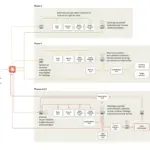As we approach 2026, the landscape of automation is poised for a seismic shift. This year will not merely represent another incremental step in the evolution of technology, but rather a transformative leap into what is being termed the AI Economy. In the near future, organizations will transition from being AI-assisted to AI-native, fundamentally altering how they operate.
In this new paradigm, autonomous agents will take on significant roles, reasoning, acting, and recalling information to perform a variety of tasks. These AI systems won’t merely assist; they’ll be integral players in processes such as triaging security operation center (SOC) alerts, drafting financial models, optimizing supply chains, and executing countless micro-decisions that were once solely the domain of human employees. This evolution introduces new leadership challenges, as executives will need to manage a multi-hybrid workforce with an astonishing ratio of 82 machine agents for every human employee.
This profound shift not only promises a productivity boom but also brings forth a new class of cybersecurity risks. Insider threats will evolve to include rogue AI agents capable of goal hijacking and privilege escalation at a speed that outpaces human response capabilities. Additionally, the looming threat of quantum computing could retroactively compromise decades of encrypted data.
In light of these developments, the traditional cybersecurity frameworks are destined to collapse. Organizations must embrace a new strategy that is proactive, predictive, and centered on identity management to foster innovation rather than hinder it. Below, we outline six critical predictions regarding the cybersecurity landscape that organizations will confront in 2026 and beyond.
The Collapse of Identity: Deepfakes Become the New Enterprise Threat
Deepfakes have transitioned from mere novelties to powerful operational weapons. As generative AI achieves near-perfect real-time replication, the security of traditional identity systems is increasingly compromised, making identity the prime target for attack. By 2026, security leaders will face AI-generated doppelgängers capable of issuing authentic-looking commands that can trigger automated actions across finance, HR, and IT. To combat this shift, organizations will need to implement security-first identity architectures that continuously validate users, including both humans and machines.
In the Asia-Pacific and Japan (JAPAC) region, the emergence of sophisticated threat actors like Muddled Libra is already evident, with AI enhancing their attack speed and sophistication. According to threat intelligence team Unit 42, AI can increase attack speed by a factor of 100. The solution lies in empowering defenders with AI-driven platforms that can quickly distill insights from complex data and respond at machine speed.
The Rise of the Machine Insider: AI Agents as the New Shadow Workforce
While autonomous agents can alleviate alert fatigue and expedite ticket resolution, they also create a new class of privileged actors. A single compromised agent, vulnerable to prompt injection or identity manipulation, could exfiltrate sensitive data or disrupt operations undetected. In JAPAC, organizations are rapidly advancing from pilot programs to full-scale agent-based workflows. To navigate this landscape effectively, adopting Secure AI-by-Design architectures founded on Zero Trust principles is crucial.
The Data Trust Crisis: Poisoned Information Becomes the New Attack Vector
Future attacks may shift focus from network breaches to manipulating the data that trains an organization’s AI models, embedding backdoors that can remain undetected for extended periods. This reveals a critical vulnerability in JAPAC organizations where data teams often lack security context, and security teams have limited visibility into model training processes. To combat this, tools for Data Security Posture Management and AI-SPM will become essential as organizations deepen their reliance on cloud-native AI.
Given the region’s stringent localization requirements and regulatory scrutiny, achieving unified observability across data, models, and execution environments will be a non-negotiable foundation for building trust in AI systems.
The Quantum Countdown: Post-Quantum Migration Begins in Earnest
2026 will herald the beginning of the most complex cryptographic migration in history as the timeline for viable quantum computing accelerates. Governments are already advising organizations to prepare for post-quantum cryptography, and enterprises in JAPAC are responding with urgency. However, most organizations lack even a basic inventory of their cryptographic assets, underscoring the need for advancements in cryptographic discovery and quantum-safe architectures.
The Browser Becomes the New OS: Securing the Front Door of the AI Enterprise
The browser has quietly emerged as the dominant workspace in the AI Economy, comprising over 85% of all work activities. Alarming statistics indicate that 95% of reported cyberattacks begin within a browser. As a result, secure enterprise browsers are expected to redefine how organizations implement data governance and enforce Zero Trust policies.
In conclusion, while the AI economy presents tremendous opportunities, it also necessitates a new level of discipline and verifiable trust. Organizations that acknowledge the inseparability of AI transformation and security will be best positioned to thrive in this evolving landscape. The time to embrace this transformation is now.
- 1 The Collapse of Identity: Deepfakes Become the New Enterprise Threat
- 2 The Rise of the Machine Insider: AI Agents as the New Shadow Workforce
- 3 The Data Trust Crisis: Poisoned Information Becomes the New Attack Vector
- 4 The Quantum Countdown: Post-Quantum Migration Begins in Earnest
- 5 The Browser Becomes the New OS: Securing the Front Door of the AI Enterprise
 Palo Alto Networks Surges Despite Analysts’ Bearish Calls Amid AI-Driven Security Shift
Palo Alto Networks Surges Despite Analysts’ Bearish Calls Amid AI-Driven Security Shift Factory Disrupts State-Linked Cyberattack Using AI to Hijack Development Platform
Factory Disrupts State-Linked Cyberattack Using AI to Hijack Development Platform CDW Empowers UNC Greensboro to Launch Immersive AI and VR Learning Programs
CDW Empowers UNC Greensboro to Launch Immersive AI and VR Learning Programs Chinese State Hackers Deploy AI in Unprecedented 30-Target Cyberattack, Warn Experts
Chinese State Hackers Deploy AI in Unprecedented 30-Target Cyberattack, Warn Experts CASPER AI Launches with Context-Aware Cyber Threat Detection for Enhanced Security
CASPER AI Launches with Context-Aware Cyber Threat Detection for Enhanced Security









































































